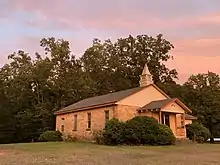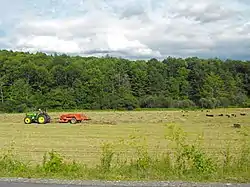Rural areas in the United States
Approximately 97% of United States' land area is within rural counties, and 60 million people (roughly 19.3% of the population) reside in these areas.[1]

Demographics
Most rural counties are experiencing persistent population decline.[2]
Compared with households in urban areas, rural households had lower median household income ($52,386 compared with $54,296), lower median home values ($151,300 compared with $190,900), and lower monthly housing costs for households paying a mortgage ($1,271 compared with $1,561). A higher percentage owned their housing units “free and clear,” with no mortgage or loan (44.0 percent compared with 32.3 percent).[1]
States with the highest median household incomes in rural areas were Connecticut ($93,382) and New Jersey ($92,972) (not statistically different from each other). The state with the lowest rural median household income was Mississippi ($40,200). Among rural areas, poverty rates varied from a low in Connecticut (4.6 percent) to a high in New Mexico (21.9 percent).[1]
About 13.4 million children under the age of 18 live in rural areas of the nation.[1]
Children in rural areas had lower rates of poverty than those in urban areas (18.9 percent compared with 22.3 percent), but more of them were uninsured (7.3 percent compared with 6.3 percent). A higher percentage of "own children" in rural areas lived in married-couple households (76.3 percent compared with 67.4 percent). ("Own children" includes never-married biological, step and adopted children of the couple).[1]
As of 2016, about 7 percent of homeless people in the United States live in rural areas, although some believe that this is an underestimate.[3]
History
Rural America was the center of the Populist movement of the United States in the 1890s. Since the 1930s, rural United States has largely been a stronghold for the Republican Party. The notable exception is Vermont, given its numerous Democrats elected to office in the 21st century.
Health
There are significant health disparities between urban and rural areas of the United States. The per capita rate of primary care physicians is lower in rural areas of the country (65 primary care physicians per 100,000 rural Americans, compared to 105 primary care physicians for urban and suburban Americans).[4] Rural Americans are also more likely than other Americans to suffer from chronic health conditions such as diabetes, heart disease, and cancer.[4]
A study published in the journal JAMA Pediatrics in 2015 analyzed data on U.S. youth suicide rates from 1996 to 2010. It found that the rates of suicides for rural Americans aged 10 to 24 was almost double the rate among their urban counterparts. This was attributed to social isolation, greater availability of guns, and difficulty accessing healthcare.[5]
Notwithstanding the economic and health challenges, a 2018 survey of rural adults found a majority felt they were better off financially than their parents at the same age. They thought their children would also experience such improvement. Forty percent said their lives came out better than they expected.[6]
Definitions

Two major official definitions are produced by the Census Bureau and the Office of Management and Budget (OMB). The Census Bureau definition is given by census tract, and policy experts note that it classifies many suburban areas as rural. The OMB definition is by county and classifies some rural areas into metropolitan counties.[7][8]
The USDA has four different systems for defining rural areas: Frontier and Remote (FAR) Area Codes, which define rural areas in four levels of increasing remoteness by ZIP Code,[9] Rural–Urban Commuting Areas (RUCA), Urban Influence Codes (UICs), and Rural-Urban Continuum Codes (RUCC).[7][10]
The United States Department of Health and Human Services has two agencies that define rural areas. The Health Resources and Services Administration addresses the shortcomings of the Census Bureau, OMB, and RUCA definitions to produce a definition that is balanced between them.[8] The Centers for Medicare & Medicaid Services uses its own definition for setting Medicare payment rates.[7]
CityLab defines rural areas by congressional district, based on census tracts and a machine-learning algorithm.[11][12]
See also
Notes
- "New Census Data Show Differences Between Urban and Rural Populations". American Community Survey, 2011–15. Bureau of the Census. December 8, 2016.
- Swenson, David (May 24, 2019). "Dwindling population and disappearing jobs is the fate that awaits much of rural America". Marketwatch. Retrieved September 18, 2019.
- Miles Bryan, In Rural America, Homeless Population May Be Bigger Than You Think, NPR All Things Considered (February 18, 2016).
- Molly O'Toole, Healthcare access lagging in rural U.S.: report, Reuters (July 27, 2011).
- Julie Beck, The Growing Risk of Suicide in Rural America, The Atlantic (March 10, 2015).
- Smarsh, Sarah (September 17, 2019). "Opinion | Something Special Is Happening in Rural America". The New York Times. ISSN 0362-4331. Retrieved September 18, 2019.
- "Modernizing Rural Health Care: Coverage, quality and innovation" (PDF). unitedhealthgroup.com. UnitedHealth Center for Health Reform & Modernization. Retrieved April 7, 2020.
- "Defining Rural Population". hrsa.gov. Health Resources & Services Administration. Retrieved March 30, 2020.
- "2010 Frontier and Remote (FAR) Area Codes". usda.gov. USDA. Retrieved March 30, 2020.
- Fontanella, Cynthia A.; Hiance-Steelesmith, Danielle L.; Phillips, Gary S. (May 2015). "Widening Rural-Urban Disparities in Youth Suicides, United States, 1996-2010". JAMA Pediatrics. 169 (5): 466–73. doi:10.1001/jamapediatrics.2014.3561. PMC 4551430. PMID 25751611.
- Skelley, Geoffrey (November 1, 2018). "Democrats Can Get Close To A House Majority With Suburban Seats Alone". fivethirtyeight.com. Retrieved April 7, 2020.
- Montgomery, David H. "Methodology". github.com. GitHub. Retrieved April 7, 2020.
Further reading
- Cynthia M. Duncan, Worlds Apart: Poverty and Politics in Rural America (2d ed.: Yale University Press, 2014).
